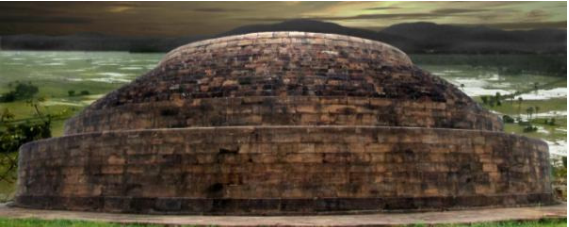Lalitgiri
Additional information may please be sent as messages to the |
Lalitgiri
(Lat - 200.35’N and Long- 860.15’E)
The earliest Buddhist Complex dating back to the 1st century AD, Lalitgiri forms an important node of the Diamond Triangle ie Lalitgiri (in present Cuttack district) and Ratnagiri and Udayagiri (in present Jajpur district). Well connected by excellent roads to Cuttack and Bhubaneswar, recent excavations here have brought to light significant archaeological material that upholds Lalitgiri as a great centre of Buddhist attraction.
The majestic ruins of the huge brick monastery, the remains of the chaitya hall, a number of votive stupas and a renovated stone stupa at the apex of a small rugged sandstone hill dominate the rural greenery around.
In addition, the museum displays a large number of Mahayana sculptures consisting of colossal Buddha figures, huge Boddhisattva statues, statues of Tara, Jambhala and others. Interestingly, most of these sculptures contain short inscriptions on them. The Standing Buddha figures, with knee length draperies over the shoulders remind one of the influence of the Gandhara and Mathura school of art. This also brings to mind the fact of Prajna, who had come from Takshasila to ancient Odisha to learn the philosophy of Yoga. He later left for China in the eigth century A.D. with an autographed manuscript of the Buddhist text Gandavyuha, from the then Odishan king Sivakara Deva 1, to the Chinese Emperor Te-tsong. The discovery of caskets containing sacred relics, probably of the Tathagata himself, from the stone stupa at the top of the hill, further enhances the sacredness of the stupa as well as of Lalitgiri for Buddhists around the world. It also brings to mind the description of Hiuen T'sang, the famed Chinese traveller of the seventh century A D, about the magnificent stupa on top of a hill at Puspagiri Mahavihara which emitted a brilliant light because of its sacredness. " On the basis of archaeological materials including inscriptions brought to light by excavation, Langudi hill in Jajpur district may be identified as Puspagiri."
Air : Bhubaneswar is the nearest airport. Well connected to Lalitagiri by bus.
Train : Cuttack is the nearest railhead well connected to major cities through broad gauge network (60 kms).
Road : Lalitagiri is well connected with Bhubaneswar (approx-85 kms), and other cities through a good road-network.
